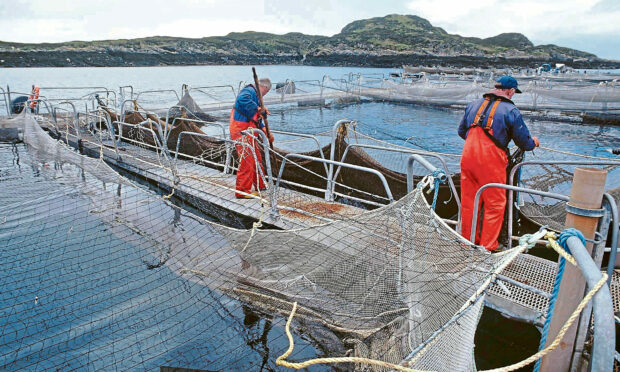A new poll has been released maintaining a majority of Scots who live near salmon farms support the sector, although one lobby group continues to push for major reform.
The research, commissioned by Salmon Scotland, revealed 54% of those with at least some knowledge of the sector were “favourable” towards it compared to those who were “unfavourable,” at 23%.
The work was carried out by independent pollsters, Ipsos Scotland, members of the British Polling Council.
There are around 200 Scottish fish farms located in Shetland, Orkney, Western Isles, North West Highlands and Bute.
Overseas sales of salmon exceeded £600m last year, reaffirming its place as the UK’s largest food export.
Sector supports around 10,000 jobs
“This poll shows that most people living near salmon farms in rural Scotland are supportive of salmon farming and appreciate the jobs this provides,” said Salmon Scotland chief executive, Tavish Scott.
“The sector supports around 10,000 jobs across Scotland and provides a nutritious food both at home and around the world, produced to the highest environmental and sustainability standards.
“We conducted this independent research among our neighbours as it’s important we listen to local communities and this confirms local people are supportive of salmon farming.
“Salmon farmers work hard to earn and keep the trust of the local communities they live and work in.
Dramatic increase in sea lice, says lobby group
However, campaign body, Inside Scottish Salmon Feedlots (ISSF) disputes the jobs figure cited and is pressing for sea lice, fish welfare, mortality and sewage issues to be addressed.
“We are still in state of purgatory with government and industry,” ISSF founder, Corin Smith told the Press and Journal. “The amount of sea lice in the water has increased dramatically, whereas [Parliamentary] committees were calling for them to reduce dramatically.
“The industry has no desire for progress. You can’t really resolve the issues of waste and sea lice without essentially including change in the industry.
“Salmon farming’s contribution to the Scottish economy is very, very small; less than 1% of GDP. The much-quoted figure of 10,000 [jobs] has been ridiculed by economists. They directly employ 1,500 on salmon farms.”
Natural lice-control methods prove “hugely successful”
Salmon Scotland insists on farm sea-lice numbers are among their lowest levels since records started and it is able to quantify that with regular fish checks, where levels are reported and published monthly.
“There has been a significant reduction in the use of medicinal treatments over the past decade in favour of natural lice-control methods including cleaner fish, which have proved to be hugely successful in controlling lice levels,” said Salmon Scotland director of strategic engagement, Hamish Macdonell.
The body added the sector has also adopted a sustainability charter to ensure its product is “produced in the most responsible and sustainable way.”
Salmon Scotland said there are concerns the growth of farming in Iceland and Scandinavia could squeeze the Scottish sector and “hold back the economic potential for rural communities.”
It notes Professor Russel Griggs recently published a report for the Scottish Government recommending a change in the regulatory structure, which would enable the sector to grow and invest better in the communities where they are based.
A spokesperson for the Scottish Environment Protection Agency (SEPA), added: “As Scotland’s environmental watchdog, SEPA believes the long-term success of the finfish aquaculture sector depends on protection of the environment being foremost in all the sector’s plans and operations.
“At SEPA we’re clear environmental compliance is non-negotiable and we’ll continue to work with a range of sectors to ensure operators meet their obligations and encourage as many as possible to go further still.
Ipsos Scotland interviewed a representative sample of 1,000 adults aged 16+ across five local areas of Scotland.
In Argyll and Bute and north-west Highland, the survey sample included only those living within a 10-mile distance from a salmon farm.
In Orkney, Shetland and the Western Isles, all postcodes were eligible.
